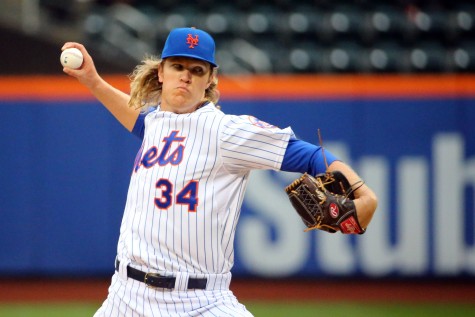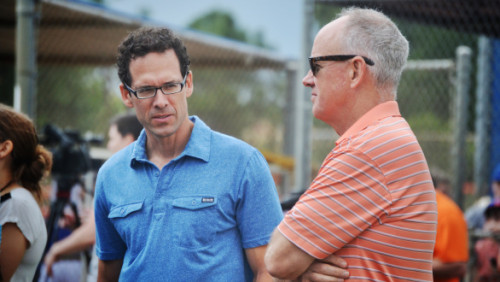As the Mets enter their first playoff series in nine years tonight, we can all agree that it sure has been a long, winding road back here. Since 2006, the Mets have experienced two managerial changes, a change in general manager, two historic collapses, and a host of mediocre seasons. For most of that time, it seemed as if the Mets were going nowhere. The organization was stuck in the purgatory of 70 to 79 wins, too many to get top draft picks, but too good to be even close to competitive.

Alderson’s method has been slow and excruciating, a definite change of pace from the Minaya era.
When Sandy Alderson took over the team after the 2010 season, it seemed as if the organization had ground to a halt. Alderson’s style was in stark contrast to Omar Minaya’s: he was about as reluctant as any executive in baseball to make any flashy moves, especially those which required the team to take on salary. Say what you will about the Wilpons’ financial state (and I will always be in the camp that they withheld and continue to withhold money), but it did save the Mets from the restricting long-term commitments that had plagued the previous front office.
This made the early years of Alderson’s regime especially frustrating. At least Minaya tried to improve the big league club, however badly he often handled that. The biggest free agents the Mets seemed to bring in were the likes of Scott Hairston and Marlon Byrd. The Yankees dropping hundreds of millions on players seemingly every offseason didn’t exactly make things better. And that frustration was totally justified. A New York team should be players in free agency and trade talks every year.
However, Alderson saw what many fans either failed or refused to see. He looked at the Yankees and realized that method of building a winning club simply wasn’t possible in Queens. The Dodgers and Yankees are the only two teams who could, in theory, build successful teams year after year by just throwing money at their problems. No left fielder? We’ll just drop $100 million over seven years to fix that problem immediately. And when that player fizzles out three years later, we’ll spend another $100 million to fix that. This model may work for teams like the Yankees and Dodgers, the only two who can afford this, but it does not work for anyone else. The only way to build is to actually build. You know, from the ground up.
As frustrating as Sandy Alderson’s first actions were, they made sense. He liquidated most of what could be dealt and saved the few long term assets available (i.e. David Wright). Trading Carlos Beltran, R.A. Dickey, John Buck, and Marlon Byrd absolutely did make the team less competitive in the near term, but they were never going to help in the long term. And as much as general managers say they want to win immediately, the goal is always to build a long-term winner. That’s what’s best for the franchise, the league, and the fans.
You see, Alderson did what few general managers these days have the gumption to do: wait it out, knowing that there’s light at the end of the tunnel. If you build up your system enough, and stock it with top-tier young talent, odds are your system is going to produce a core of young, above-average, cheap players. In my opinion (and it seems like this is Alderson’s opinion too), you cannot win year after year without a young, cheap, core group of players. Even the Yankees, who I just said were the exception, needed Derek Jeter, Bernie Williams, Andy Pettitte, Mariano Rivera, and Jorge Posada to win in the late-90s.

Having cheap, controllable players like Syndergaard frees up millions of dollars to spend elsewhere if needed.
Stockpiling prospects, however unglamorous, is the best way to build this young core. With high prospect failure rates, you can’t just rely on one or two to save your franchise.
For years, the Mets did nothing but bring in top and middle-tier prospects. In fact, Michael Fulmer was, by far, the biggest prospect to be dealt during the Sandy Alderson regime. But more importantly, having a young core frees up a ridiculous amount of money to fill whatever miscellaneous holes your team has. This is where Bartolo Colon, Curtis Granderson, and Michael Cuddyer fit in. When you look at the Mets’ starting four heading into the division series, not only are all four absolute studs, but they all make the league minimum. In fact, Noah Syndergaard, Jacob deGrom, and Steven Matz will all be making the league minimum for multiple years. That’s part of what makes this all sustainable. Then you add in Michael Conforto and Travis d’Arnaud. Heck, even throw Matt Harvey in there, even though he’s arbitration-eligible this winter. All six of those guys will, combined, cost the Mets less than $10 million next season.
These last few years have been very trying for most Mets fans. Prospects develop slowly, and that sucks. Money has been tight, and hard decisions had to be made. Did Alderson do a perfect job in getting us here? Absolutely not. He has made some glaring mistakes. However, he’s limited his mistakes enough that he’s kept on this steady, gradual path towards a winning ballclub.
Building a team the right way requires diligence, patience, and the ability to withstand flak from fans and the media. Whatever you think about Alderson’s approach to baseball, how he acquired (or didn’t acquire) some of his prospects, or how he’s handled the media over these last few years, it’s clear that the hard-but-necessary path he took this franchise on has paid off. I can honestly sit here and say that the Mets are going to be good, and no matter what happens tonight, this weekend, or in the weeks ahead, they’re going to be good for many years to come.
Boy, does it feel good to say that.
















